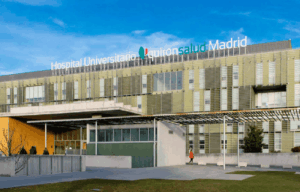Intervertebral hernia
Disease description
An intervertebral hernia is a pathological condition in which a portion of the intervertebral disc protrudes or shifts beyond its anatomical boundaries. This displacement can compress the spinal cord or nerve roots, leading to pain, sensory disturbances, and limited mobility.
Symptoms indicating the need for diagnosis and treatment:
- acute or chronic back pain radiating to the leg or arm, worsening with deep breathing, physical activity, coughing, or sneezing
- numbness, tingling, or weakness in the extremities
- reduced spinal mobility
- urinary dysfunction and erectile disorders (in severe cases)
Diagnostic and treatment methods
Diagnosis
The diagnosis of an intervertebral hernia is primarily made using magnetic resonance imaging (MRI), which provides detailed images of the spine and allows for assessment of the degree of disc protrusion and its impact on neural structures. In certain cases, computed tomography (CT) and electromyography (EMG) are used to evaluate nerve function.
Treatment
Treatment of intervertebral hernia usually begins with conservative methods, including pharmacotherapy (analgesics, anti-inflammatory medications, muscle relaxants), physical therapy, and therapeutic exercise. If conservative treatment fails to provide relief, surgical intervention is performed, such as microdiscectomy or endoscopic surgery, aimed at removing the herniated disc portion and relieving pressure on the nerve roots.
Innovations in global clinics
In advanced clinics, robot-assisted surgical systems such as the da Vinci robotic platform are now being used for the operative treatment of intervertebral hernias.
The da Vinci system enables surgeons to perform highly precise procedures through minimal incisions with reduced risk of complications. It provides a 3D view of the surgical field and allows for enhanced control of micro-instruments, which is especially critical when working with delicate spinal structures.
Procedures
Top clinics
-
 Munich, Germany Orthopedic Center of Professor Lill
Munich, Germany Orthopedic Center of Professor Lill -
 Seoul, South Korea Asan Medical Center
Seoul, South Korea Asan Medical Center -
 Jerusalem, Israel Hadassah Medical Center
Jerusalem, Israel Hadassah Medical Center -
 Petah Tikva, Israel Medical Center “Rabin”
Petah Tikva, Israel Medical Center “Rabin” -
 Istanbul, Turkey Istanbul Florence Nightingale Hospital
Istanbul, Turkey Istanbul Florence Nightingale Hospital -
 Geneva, Switzerland Generale-Beaulieu
Geneva, Switzerland Generale-Beaulieu -
 Istanbul, Turkey Acibadem Altunizade
Istanbul, Turkey Acibadem Altunizade -
 Antalya, Turkey Hospital Medical Park Antalya
Antalya, Turkey Hospital Medical Park Antalya -
 Dubai, UAE NMC Healthcare
Dubai, UAE NMC Healthcare -
 Graz, Austria Leech Private Hospital
Graz, Austria Leech Private Hospital -
 Abu Dhabi, UAE Burjeel Hospital Abu Dhabi
Abu Dhabi, UAE Burjeel Hospital Abu Dhabi -
 Vienna, Austria Debling Private Clinic
Vienna, Austria Debling Private Clinic -
 Vienna, Austria Confraternität Private Hospital
Vienna, Austria Confraternität Private Hospital -
 Dubai, UAE Burjeel Hospital
Dubai, UAE Burjeel Hospital -
 Hamburg, Germany Asklepios Nord Heidberg
Hamburg, Germany Asklepios Nord Heidberg -
 Dusseldorf, Germany FKKD Clinical Complex
Dusseldorf, Germany FKKD Clinical Complex -
 Seoul, South Korea Sarang Plas Clinic
Seoul, South Korea Sarang Plas Clinic -
 Incheon, South Korea Gil Medical Center at Gachon University
Incheon, South Korea Gil Medical Center at Gachon University -
 Nyon, Switzerland Clinique Genolier
Nyon, Switzerland Clinique Genolier -
 Seoul, South Korea H+ Yangji Hospital
Seoul, South Korea H+ Yangji Hospital -
 Barcelona, Spain QuironSalud Barcelona Hospital
Barcelona, Spain QuironSalud Barcelona Hospital -
 Barcelona, Spain Medical Center "Teknon"
Barcelona, Spain Medical Center "Teknon" -
 Barcelona, Spain Sant Joan de Deu Children's Hospital
Barcelona, Spain Sant Joan de Deu Children's Hospital -
 Barcelona, Spain University Hospital Barnaclinic+
Barcelona, Spain University Hospital Barnaclinic+ -
 Madrid, Spain University Clinic HM Madrid
Madrid, Spain University Clinic HM Madrid -
 Gebze, Turkey Anadolu Clinic
Gebze, Turkey Anadolu Clinic -
 Zurich, Switzerland Hirslanden Clinic
Zurich, Switzerland Hirslanden Clinic -
 Madrid, Spain Quiron Salud University Hospital
Madrid, Spain Quiron Salud University Hospital -
 Seoul, South Korea Samsung Medical Center
Seoul, South Korea Samsung Medical Center -
 Bursa, Turkey Doruk Nilüfer Hospital
Bursa, Turkey Doruk Nilüfer Hospital -
 Seoul, South Korea Medical Center at Ewha Womans University
Seoul, South Korea Medical Center at Ewha Womans University -
 SNUH
SNUH
































